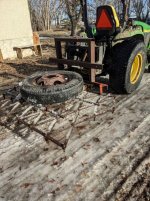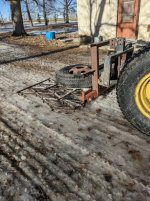pmsmechanic
Elite Member
- Joined
- Dec 6, 2013
- Messages
- 4,348
- Location
- Southern Alberta, Canada
- Tractor
- 4410 and F-935 John Deere, MF 245
I like you idea! Mine was a bit simpler to build but yours is considerably more robust and compact. I drive in reverse with mine because the edges are sharper on the back edge and they dig into the ice better. You could easily make yours to pull in both directions and always have sharp edges or just drive in reverse like I do.Similar here, except my drive is all uphill. I made what I call an ice ripper. simple C channel with spikes welded and 3pt frame. The tips are starting to round off, but have been using it for over ten years, but only need it occasionally when the conditions are just right to make drive ice.

